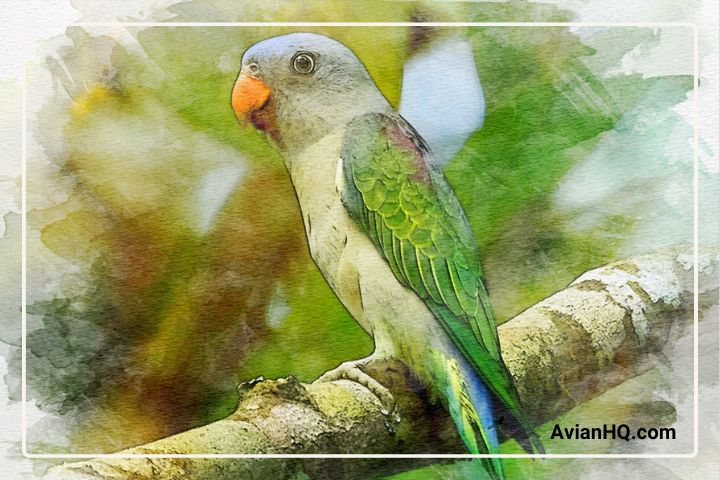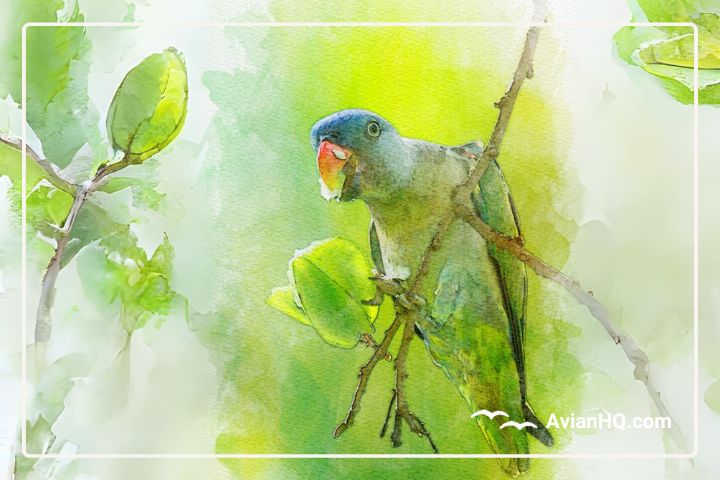Blue-rumped Parrot (Psittinus cyanurus)
The brilliant flash of blue on a canopy branch catches your eye as a charming little parrot comes into view. You gaze in delight at the beautiful plumage of the Blue-rumped Parrot, taking in its distinguishing features. Though small, this parrot makes up for its size with its oversized personality.
Known scientifically as Psittinus cyanurus, the Blue-rumped Parrot stands out with its bright green body, blue rump and tail, red beak, and black and yellow markings on its wings. The name “cyanurus” even comes from the Ancient Greek words “cyan” meaning blue and “oura” meaning tail. This colorful naming choice perfectly matches the parrot’s striking appearance.
While gorgeous, the Blue-rumped Parrot does not just coast on its looks alone. It charms with its playful nature, acrobatic movements, and vocalizations that fill the forests of its island habitats. Weighing in at just 30 grams or 1 ounce fully grown, you’ll be impressed at how much character can be packed into such a small package.
Prepare to fall in love with this little parrot. Let’s dive deeper into the captivating world of the Blue-rumped Parrot. Its behaviors, habitats, conservation status and more reveal what makes this species so special. You’ll never look at a flash of blue in the forest canopy the same way again!
Physical Appearance
The Blue-rumped Parrot lives up to its name with its bright blue rump and upper tail feathers. But that’s not the only pop of color on this small parrot.
Reaching just 7 inches (18 centimeters) in length and weighing 0.6 to 1 ounce (18 to 30 grams), the Blue-rumped Parrot packs a lot of vibrance into its tiny body. Its green plumage covers the chest, back and wings. It’s head is gray with a bluish tinge. Its wings feature a darker green color with a maroon shoulder patch, adding even more dramatic flair. The parrot’s orange beak and feet provide the perfect finishing touch.
The Blue-rumped Parrot exhibits sexual dimorphism where the males and females differ in appearance. The most notable difference is the bright blue patch on the rump and tail, which is duller and more greenish in the female. Females also have a whitish eye-ring not seen in males.
The blue rump provides camouflage as the parrots forage high in the forest canopy. When seen from below, the blue helps them blend in with filtered sunlight. Despite their small size, those flashes of blue still give their presence away!
Habitat and Distribution
The Blue-rumped Parrot occupies tropical forests and woodlands up to elevations of 3,000 feet (914 meters). Its range extends across parts of Southeast Asia and Indonesia.
This species makes its home primarily on the islands of Borneo, Sumatra, the Natuna Islands and nearby smaller islands. It resides mainly in Malaysia and Indonesia. However, its range also reaches into some coastal areas of Thailand and Burma.
Within its forest habitat, the Blue-rumped Parrot forages for fruit and nests high in the tree canopy. It prefers primary rainforests but also inhabits secondary forests, wooded regions and mangroves. Palm trees provide a particular favorite nesting spot.
These parrots are non-migratory and maintain small home ranges. Their distribution remains somewhat patchy across their territory. But despite their small size, they manage to make the most of the forest resources available within their local climate.
Diet and Feeding
The Blue-rumped Parrot is primarily frugivorous, feeding on various fruits and some seeds. Its preferred diet includes figs, berries, drupes, and other small fruits.
This species forages mainly high in the forest canopy, using its curved beak to pluck fruit and manipulate food. The parrots may feed on over 50 species of plants, including palms, laurels, and fig trees. They have also been observed foraging in small flocks.
Blue-rumped Parrots supplement their fruit diet with some insects, nectar, and pollen. Their feeding techniques include reaching and clinging acrobatically to branches and foliage to access food.
On average, these parrots eat 19 to 26 grams (0.7 to 0.9 ounces) of food per day. With their high metabolisms and energy needs for flying, they must continuously forage across their home ranges daily. Their lively feeding behaviors help disperse seeds through the forest as well.
Breeding and Reproduction
The Blue-rumped Parrot breeds between February and June. This coincides with the wetter season when food supplies are more abundant.
These parrots nest high up in tree hollows, often 20 to 49 feet (6 to 15 meters) above ground. Both the male and female participate in choosing the nesting site. The female then remains in the nest hollow while the male gathers material to seal up the opening, leaving just a small entrance hole.
Clutch size is typically 2-4 white eggs which the female incubates over 18-21 days. The male continues to bring food to the female while she incubates. Once hatched, both parents feed the chicks.
The chicks fledge at about 30 days old but remain dependent on the parents for an additional 2-3 weeks. In some cases, the parents may go on to raise a second brood in the same breeding season before the fledglings fully disperse.
Breeding pairs remain monogamous and may reuse the same nest for several seasons. The pairs also actively defend their nesting territories from other Blue-rumped Parrots.
Vocalizations
The vocalizations of the Blue-rumped Parrot help it communicate and interact. This highly social and noisy species utilizes a wide repertoire of calls and contact notes.
Their most common vocalization is a series of high-pitched, squeaky “keet” sounds. These function as contact calls during flight and foraging to maintain group cohesion. They also use these calls back and forth when paired or grouped on branches.
Other vocalizations include more raspy, guttural “rack-rack” alarm calls. These alert the flock to danger. During aggression displays, they may make low, growling “rrr” sounds.
Whistles, chirps, and excited chattering also help the parrots socialize. Their calls ring loudly through their forest habitat despite their small size!
Various vocalizations play roles in courtship as well. Duets between paired males and females help maintain the bond. Specific calls even help synchronize breeding between pairs.
The wide array of noises from this little parrot species brings energy and activity to its tropical ecosystem. Their chatter provides a constant soundtrack in the forests they inhabit.
Conservation Status
The Blue-rumped Parrot is currently classified as Near Threatened on the IUCN Red List of Threatened Species. Its global population has not been formally quantified but is estimated to number over 100,000 individuals.
However, the species is assumed to be undergoing a moderately rapid population decline. Extensive deforestation across the Sundaic lowlands has reduced its natural lowland forest habitats. It is also impacted by capture for the pet trade.
The Blue-rumped Parrot has a limited native range concentrated mainly on the islands of Borneo and Sumatra. Habitat loss poses the most significant threat as it reduces available nesting sites and food sources.
This species can utilize secondary forests and modified habitats, which has kept it from being considered a threatened status. It also inhabits lower montane forests which are less impacted than lowland regions. But ongoing habitat pressures still raise concerns.
Conservation efforts aim to protect remaining intact forests through wildlife reserves. Anti-poaching measures and restrictions on capture for the pet trade seek to relieve pressure on wild populations. Ongoing monitoring of population trends will be important for the Blue-rumped Parrot’s future.
Cultural Significance
The Blue-rumped Parrot has little special significance in indigenous folklore or culture. However, its bright colors and lively nature still make it an eye-catching species.
The Blue-rumped Parrot does not serve as any nation’s national bird. But its flashy plumage makes it a favorite among birdwatchers and ecotourists. Birding tours in Borneo, Sumatra and other parts of its range commonly highlight sightings of this species.
Artworks and literature also depict this parrot. Its distinctive red, green and blue coloration attracts artistic interest. The Blue-rumped Parrot stands out as a symbol of the remarkable biodiversity found in Southeast Asia’s tropical forests.
While not culturally iconic, the Blue-rumped Parrot remains a charismatic species. Its beauty and energetic nature will hopefully continue inspiring efforts to protect its fragile forest home.
Conclusion
The Blue-rumped Parrot may be small, but it has a larger-than-life presence. This colorful and energetic species brings vibrance to the tropical forests it inhabits.
With its green body, blue rump and tail, red beak, and bold wing markings, the Blue-rumped Parrot dazzles the eyes. Its vocalizations ring loudly through the canopy as well. Despite reaching only 7 inches long, this parrot has a huge personality.
From acrobatic foraging to complex social behaviors, the Blue-rumped Parrot is a captivating creature. While not endangered, habitat loss and trade pressures still pose risks. Ongoing conservation efforts will hopefully preserve both this species and the forests it calls home.
The next time you are birdwatching in Southeast Asia’s wooded tropics, listen and watch closely for that flash of blue. Let the spectacular Blue-rumped Parrot brighten your day, just as it brightens its forest ecosystem. The vibrant lives of this petite parrot species demonstrate that big things really can come in small packages.



